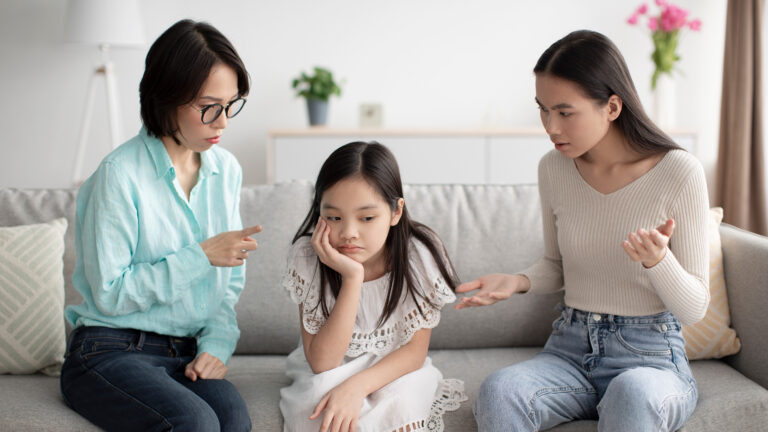Real Talk
Guilt Trip: A Common Toxic Tactic in Filipino Families
When Filipino parents can’t get their kids to follow them, they sometimes employ the toxic tactic known as guilt-tripping.
“Maawa naman kayo sa akin,” “I never complain when you ask me to do things for you!”, “Sige, bahala ka sa buhay mo!” — if ever we catch ourselves saying these things to our kids or recall that our parents once used statements on us, there’s a name for that tactic. We call it The Guilt Trip; it’s a tactic that sometimes our elders (or sometimes, even we) subconsciously use against our children to force them to comply. But Many Filipino families may feel that this technique is harmless, attributing it to teaching Utang na Loob.
However, there’s a deeper, darker, and more manipulative side to this. It starts out with small requests before developing into more sensitive demands, including ones about money.

What does it mean to “Guilt Trip” someone?
Emotions serve as a motive behind every person’s actions. Happiness, sadness, anger, and even spite can drive even the most collected people to take drastic measures, especially when they’ve certainly had enough. Guilt, being one of the stronger emotions, can also serve as a powerful influencer. Because it’s mixed with feelings of self-loathing and shame, the social element behind guilt makes it even more persuasive as a motive.
Guilt Trip, from the name itself, weaponizes the individual’s shame to persuade them to do something. When a person uses a favor they once did for a person to persuade, it creates “mental debt.” We now feel that because they did something for us, we’re obligated to pay them back. It transforms gratitude into the proverbial “shackle” when constantly used, conditioning a person to believe that the other person’s needs matter more than theirs.
Unfortunately, it hits Filipinos hard because of their core value of hiya or shame (Bulatao, 1964; Lasquety-Reyes, 2016). Being highly aware of how denying the request will affect their social image, many of them prefer simply saying “yes” to avoid causing stress and drama in the family.
How Filipino families use this technique
The Guilt Trip technique is most common in Filipino families, most especially immigrant ones (Li, 2022). While the hardships of migrating the whole family are nothing to laugh at, the unprocessed emotions can make those who suffered create bargaining chips out of those moments. Especially when influenced by the need for a strong family identity through filial piety, some Filipino elders use this technique because of their fear of losing their place in the family. These quarrels often happen in the family room of the house, with statements like these flying around:
- “Wala kang utang na loob!” / “You have no sense of gratitude!”
- “Sige, gawin mo lang!” / “Go ahead, do it!”
- “Ginawa ko ang lahat para sa pamilya na ito at ito lang ang bibigyan mo sa akin!?”/ “I’ve done everything for this family and this is what I get!?”

But not all Guilt Trip techniques are loud. Some are more covert, which we dub the “Cold War” style. No yelling, screaming, or explicit shaming but, the silence will say it all. Filipino parents do this with each other when they feel unappreciated and the usual casualty here are the kids. From using the kids as mouth-pieces or constantly calling the kid’s away when the other parent wants to spend time with them for no urgent reason, these are multiple ways we may be doing it to our partners. Although, we don’t see the effects immediately. But the signs will show in our kids’ friendships and even their romantic relationships in the long run.
The Impact The Guilt Trip Tactic Has On Kids
Every so often, we will resort to using the Guilt Trip to get what we want. But when used constantly, it can have profound effects on our kids’ emotional and mental development. Because guilt is an emotion strongly tied to being abandoned and rejected, children can develop in three ways: they can either be hyper-independent, extremely people-pleasing or become manipulative themselves.
While there is nothing wrong with raising independent children, making them hyper-independent means they are so self-reliant that they will see any form of help or compassion as a sign of weakness — even from us, their own parents! They will also constantly repress their emotions because this allows them to avoid two things: feelings of guilt when they fail someone and fear of the possibility of being rejected (Nleko, 2022).
On the other hand, people-pleasing also achieves the same objective but with different methods: by creating a highly generous persona. Constantly offering help, a willing ear to listen to people’s problems, and even solving the problem for others (even when they are clearly not capable) — these are all in avoiding the guilt by creating a socially acceptable and lovable appearance. They feel that this reduces the chances of people abandoning or rejecting them (Goodenough, Waite, and Bartlett, 2015).
The worst-case scenario, however, is when they become the manipulators themselves. Developing what many loosely call a “narcissistic” personality (Bleiberg, 1984; Pincus, Cain, and Wright, 2014). While Bleiberg’s study demonstrates that some genetic mutations in the brain can make kids narcissistic, more recent studies support that these are learned behaviors. When kids see their parents using this technique on one another with favorable results, they learn, “Hey, I can do this with people and get what I want!”
How do we stop guilt-tripping others and vice-versa?
While it’s socially difficult and taxing to convince an older relative to stop such a toxic tactic in Filipino families, younger generations can start by working on a different way to view mistakes and boundaries. Not all boundaries are inflexible; there are some people who are willing to negotiate. Building the patience to explain and negotiate why there’s a certain need can lessen the guilt trip. That way, the relative can make an informed decision without resentment.
Compassion motivates just as well as guilt!
While many older members of Filipino families believe that shame and guilt are the best way to keep the family together because it makes them think about others, it does not work the same way when one becomes strong enough and determined enough to break away from it. And although guilt can persuade people to do things, they’ll feel more that they “had to do it” instead of wanting to do it. So before we try to shame and guilt trip people into something, remember that nobody can force them to do that. Not even God.
References
Bulatao, J. C. (1964). Hiya. Philippine Studies, 12(3), 424-438.
Bleiberg, E. (1984). Narcissistic disorders in children. Bulletin of the Menninger Clinic, 48(6), 501-517.
Goodenough, A., Waite, S., & Bartlett, J. (2015). Families in the forest: guilt trips, bonding moments and potential springboards. Annals of Leisure Research, 18(3), 377-396.
Lasquety-Reyes, J. (2016). In defense of hiya as a Filipino virtue. Asian philosophy, 26(1), 66-78.
Nleko, G. (2022). Women’s Experience of Intermittent Father Absence: Healing, Resilience, and Coping with Ambiguous Loss (Doctoral dissertation, Alliant International University).
Li, M. (2022). Guilt and compensation: The interplay between maternal emotions and parent–child relationships in migrant families. Family Relations.
Pincus, A. L., Cain, N. M., & Wright, A. G. (2014). Narcissistic grandiosity and narcissistic vulnerability in psychotherapy. Personality Disorders: Theory, Research, and Treatment, 5(4), 439.
More Real Talk:
Sunshine Dizon: Lights, Courage, Closure!
How Utang na Loob Made Filipino Families Toxic
“Ikaw na!”: What Smart Shaming Is And Why We Shouldn’t





